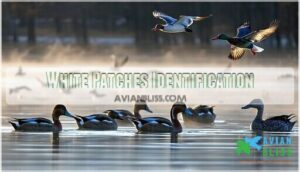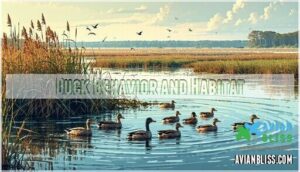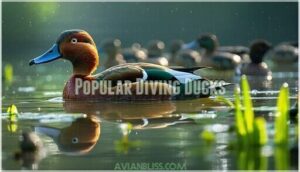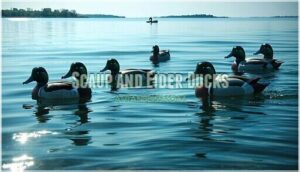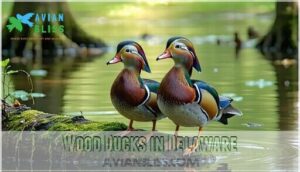This site is supported by our readers. We may earn a commission, at no cost to you, if you purchase through links.

Mallards and American black ducks dominate freshwater areas year-round, while northern pintails and gadwalls arrive during fall migration.
Canvasbacks and ruddy ducks prefer deeper waters for diving, and northern shovelers use their distinctive spoon-shaped bills to filter food from shallow marshes.
American wigeons graze on aquatic vegetation throughout coastal areas.
Delaware sits perfectly along the Atlantic Flyway, making it a hotspot for waterfowl from October through March.
Each species has unique features that make identification straightforward once you know what to look for, and understanding these species is key to enjoying the state’s waterfowl and wetlands during the migration season from October through March, especially for northern pintails.
Table Of Contents
- Key Takeaways
- Delaware Duck Species
- Duck Migration Patterns
- Identifying Delaware Ducks
- Duck Behavior and Habitat
- Popular Delaware Duck Types
- Frequently Asked Questions (FAQs)
- What kind of Ducks are in Delaware?
- Where do the Delaware Ducks play?
- Are the Mighty Ducks still a team?
- What is Delaware’s hockey team?
- What ducks are in Delaware?
- Where are the Delaware Ducks located?
- Are the Oregon Ducks a hockey team?
- What is the most common duck in Delaware?
- Are there any endangered duck species?
- What are the main threats to Delawares duck populations?
- Conclusion
Key Takeaways
- You’ll spot eight main duck species in Delaware, including mallards, canvasbacks, pintails, gadwalls, shovelers, ruddy ducks, wigeons, and wood ducks.
- You can identify Delaware ducks by checking their beak shape, plumage patterns, white patches, and listening for distinct calls.
- Delaware’s wetlands and ponds are prime duck habitats, with different species preferring deeper waters, marshes, or freshwater areas.
- Duck migration peaks from October to March, so you’ll see new waterfowl arrivals each season along the Atlantic Flyway.
Delaware Duck Species
You’ll find eight distinct duck species calling Delaware’s waterways home throughout the year.
These birds range from the familiar mallard to specialized diving ducks like the canvasback that frequent coastal marshes and freshwater ponds across the state.
Mallard Ducks
You’ll easily spot mallards throughout Delaware’s wetlands year-round.
These adaptable waterfowl thrive in diverse habitats from coastal marshes to suburban ponds, making them the state’s most common duck species.
Key mallard identification features:
- Males: Iridescent green heads with white neck rings
- Females: Mottled brown plumage with orange bills
- Both sexes: Blue wing patches (speculums) with white borders
- Size: 20-26 inches long with 32-37 inch wingspans
- Calls: Distinctive quacking sounds, louder in females.
Mallard behavior includes dabbling feeding patterns where they tip forward to reach aquatic vegetation.
Their mallard diet consists of seeds, plants, insects, and small fish.
Mallard breeding occurs from March through July, with females selecting nest sites near water.
These delaware ducks demonstrate excellent mallard conservation success, maintaining stable populations across various mallard habitat types throughout the state’s waterfowl areas.
American Black Duck
American Black Ducks face serious challenges in Delaware’s wetlands.
Habitat loss from coastal development threatens these dark-plumaged waterfowl.
Conservation efforts focus on protecting marshes where they feed on aquatic plants and invertebrates.
Hybridization threats with mallards concern biologists studying Delaware waterfowl populations.
Hunting regulations help manage duck species numbers during waterfowl hunting seasons throughout the state.
Canvasback
Canvasback ducks are diving specialists that prefer deeper waters for their underwater foraging adventures.
Canvasback ducks master deep-water diving with sleek profiles built for underwater hunting expeditions.
These elegant waterfowl showcase distinctive wedge-shaped profiles and rusty-red heads on males during breeding season.
Canvasback identification becomes easier when you spot their sloping foreheads and long bills perfectly designed for diving.
Their canvasback diet consists mainly of aquatic vegetation and small invertebrates.
Canvasback habitat includes Delaware’s coastal marshes and deeper freshwater areas.
Canvasback migration brings these diving ducks through Delaware during fall and spring movements.
Canvasback conservation efforts help maintain stable populations for delaware waterfowl enthusiasts and duck hunting delaware participants.
These migratory birds represent premium waterfowl hunting opportunities when seasons permit.
They share similar habitats with the diving and foraging tufted duck.
Northern Pintail
Elegance defines the Northern Pintail’s profile in Delaware’s waterways.
You’ll spot this graceful duck by its chocolate-brown head and distinctive white neck stripe during Pintail Breeding season.
Pintail Diet consists mainly of seeds and aquatic plants.
Pintail Identification becomes easier when noting their long, slender necks and pointed tails.
Migratory birds like pintails face Pintail Threats from habitat loss, making Pintail Conservation efforts essential for waterfowl hunting and duck hunting delaware enthusiasts who value waterfowl migration patterns, and understand the importance of Delaware’s waterways.
Gadwall
Gray-brown waterfowl with subtle beauty, Gadwall ducks prefer shallow freshwater areas throughout Delaware.
These dabblers show distinctive white wing patches during flight. Gadwall identification becomes easier when you spot males’ black rumps and females’ mottled brown plumage.
Their omnivorous diet includes aquatic plants and small invertebrates. Conservation efforts protect their wetland habitats from development pressures, which is crucial for the conservation efforts.
Northern Shoveler
You’ll spot northern shovelers by their oversized spoon-shaped bills that filter tiny organisms from shallow water.
These Delaware ducks prefer mudflats and marshes with rich invertebrate populations.
Shoveler diet consists mainly of aquatic insects and small crustaceans.
Their specialized bill adaptations make them efficient filter feeders.
During shoveler breeding season, males display distinctive green heads while females remain brown for protection.
Ruddy Duck
You’ll recognize Ruddy Ducks by their compact build and stiff tail feathers that stick straight up like tiny periscopes.
Males sport bright blue bills during breeding season while females maintain gray-brown plumage year-round.
Their diving duck behavior and preference for shallow freshwater ponds makes duck identification easier.
Delaware wildlife enthusiasts spot them in marshes where waterfowl conservation efforts protect their habitat.
American Wigeon
American wigeons waddle through Delaware’s marshes like feathered comedians with their distinctive white crown patches.
You’ll spot these dabbling ducks in shallow wetlands where they graze on aquatic plants and algae.
Their high-pitched whistling calls make wigeon identification straightforward during bird watching delaware adventures.
These delaware wildlife favorites prefer coastal marshes and freshwater ponds for wigeon habitat.
Wigeon behavior includes surface feeding and occasional diving.
Waterfowl conservation efforts protect these charming water birds throughout their range.
Duck Migration Patterns
You’ll find that Delaware’s duck populations follow distinct seasonal patterns throughout the year. Some species migrate through the state during specific seasons while others call Delaware home year-round.
Winter Migration
During peak migration months from late October through December, you’ll witness thousands of ducks using Delaware’s Winter Habitats along the Atlantic Flyway.
Delaware’s migration spectacle draws thousands of waterfowl through the Atlantic Flyway each winter season.
Migration Triggers like cold fronts push species south in waves.
Food Availability in coastal marshes and tidal creeks attracts over 150,000 waterfowl by January.
Fall migration peaks in November, offering prime viewing opportunities.
Conservation Efforts maintain these critical stopover sites for bird watching delaware enthusiasts.
Summer Migration
Summer migration transforms Delaware’s wetlands as breeding ducks head north.
You’ll notice dramatic population shifts across waterways during this season:
- Mallard and Gadwall numbers drop 60% as pairs seek northern breeding grounds
- Canvasback populations plummet over 80% along the Delaware River
- Northern Pintail sightings decrease to fewer than 500 individuals statewide
- Ruddy Ducks and American Wigeons virtually disappear from Chesapeake Bay tributaries
- Wood Ducks buck the trend, increasing through August in summer habitats
Post-nuptial migration patterns reveal how molting patterns and duckling survival needs drive these movements away from Delaware’s coastal marshes toward cooler breeding season territories.
These movements are part of complex migratory bird patterns, which include breeding season and population shifts, and are influenced by the need for cooler breeding season territories.
Year-Round Residents
While summer brings migrating visitors, some duck species call Delaware home all year.
Wood ducks remain constant residents throughout the state’s freshwater ponds and Delaware River tributaries.
Their nesting habits adapt to local conditions, with breeding success tied to habitat preservation efforts.
Population dynamics stay stable when hunting regulations protect these permanent residents during hunting season.
Identifying Delaware Ducks
You can identify Delaware’s duck species by examining four key features that make each one unique.
Look at beak shapes, white patches, head and tail characteristics, and listen to their distinct calls to distinguish between the eight common species found in the state, which can help identify distinct calls.
Beak Shape Identification
Duck beaks reveal feeding secrets that’ll transform your identification skills. Each species sports unique beak morphology perfectly suited for their preferred meals and hunting techniques.
- Broad, flat bills on mallards and gadwalls work like tiny strainers with lamellae function filtering seeds and plants
- Narrow, pointed beaks help diving ducks like canvasback grab fish and aquatic insects with precision
- Bill coloration changes seasonally – watch for bright orange on northern shovelers during hunting season
- Hybrid beaks occasionally appear when species interbreed, creating puzzling combinations that challenge even experienced hunters using duck decoys
For further assistance, resources are available for duck beak identification.
White Patches Identification
White patches serve as reliable field marks when you’re scanning waterfowl on the Delaware River or Chesapeake Bay.
Patch Location varies by species and gender.
Size Variation helps distinguish similar ducks.
Male canvasbacks show white backs while females display brown tones.
Age Influence affects patch brightness in juvenile birds.
Gender Differences create distinct identification opportunities for experienced watchers using duck decoys near public hunting areas.
| Species | Male White Patches | Female White Patches | Hunting Gear Tips |
|---|---|---|---|
| Canvasback | Bright white back | Pale gray-brown back | Use realistic decoys |
| Northern Pintail | White breast stripe | Muted white markings | Focus on neck details |
| American Wigeon | White crown patch | Light brown crown | Watch for Feather Detail |
| Gadwall | White wing patches | Small white speculum | Note Size Variation |
Calls and Sounds
Along Delaware’s waterways you’ll discover each species has distinct duck vocalizations that reveal their identity.
Mallards produce classic loud quacks while American black ducks emit deeper gruff calls.
Northern pintails whistle sharp two-note sounds and canvasbacks give soft wheeping notes.
These call meanings help distinguish species in dense marshes along the Delaware River and Chesapeake Bay where alarm calls warn of danger during hunting seasons.
Hunters may also be interested in purchasing a duck call to attract specific species, utilizing specific sounds to locate their desired target species.
Heads and Tails Identification
Look at the head shape first – it’s like reading a duck’s ID card.
Male mallards sport emerald heads while females show brown patterns.
Bill color changes with seasons in many species.
Notice how canvasbacks have sloped profiles compared to ruddy ducks’ rounded heads.
Tail feathers tell stories too.
Pintails display distinctive pointed tails year-round.
Wood ducks in Delaware state parks show crested heads.
Check plumage patterns along Delaware River and Chesapeake Bay for seasonal changes.
Stiff-tailed ducks show a signature upright posture.
Duck Behavior and Habitat
You’ll discover that Delaware’s ducks exhibit distinct behaviors based on their feeding styles and preferred habitats.
Dabbling ducks like mallards feed at the surface while diving ducks such as canvasbacks plunge underwater for food in coastal marshes and freshwater ponds throughout the state.
Dabbling Ducks Behavior
You’ll spot dabbling ducks performing their signature "tip-up" feeding behavior in Delaware’s shallow waters.
These surface feeders demonstrate fascinating behaviors:
- Feeding Habits: They filter food from water surfaces and mud bottoms
- Mating Rituals: Males display colorful plumage during spring courtship
- Social Interactions: They form loose flocks during migration seasons
- Duckling Development: Broods follow mothers to learn foraging techniques
- Predator Avoidance: Quick takeoffs from water provide escape routes
To properly identify species, use a helpful duck identification resource.
Diving Ducks Characteristics
Unlike dabbling ducks that feed at the surface, diving ducks possess specialized traits for underwater hunting.
Their Streamlined Bodies cut through water efficiently while Buoyancy Control helps them submerge completely.
Diving Physiology includes denser bones and compact feathers.
Foot Propulsion powers their descent as webbed feet act like paddles.
Underwater Foraging becomes effortless with these adaptations.
| Feature | Diving Ducks | Dabbling Ducks |
|---|---|---|
| Body Position | Low in water | High on surface |
| Feeding Method | Submerge completely | Tip forward only |
| Takeoff Style | Running start needed | Direct vertical lift |
| Bone Density | Heavier for diving | Lighter for buoyancy |
| Leg Placement | Set back for propulsion | Centered for walking |
Coastal Marshes Habitat
Delaware’s coastal marshes support over 30 migratory duck species annually.
These brackish wetlands along Delaware Bay provide critical stopover habitat where ducks find invertebrates and seeds.
Rising salinity levels and invasive species like Phragmites threaten marsh ecology.
Water quality impacts from nutrient runoff create algal blooms.
Habitat conservation efforts protect these essential Delaware natural resources, including efforts to preserve marsh ecology.
Freshwater Ponds Habitat
Freshwater ponds create perfect nurseries for Delaware’s duck populations.
These calm waters support abundant aquatic plants and insects that fuel duck diets throughout breeding season.
Pond ecology provides shelter from predators while offering ideal nesting sites along vegetated shorelines.
- Waterway activities: You’ll spot dabblers like mallards feeding on surface vegetation while divers plunge deep for small fish
- Natural attractions: Ponds attract diverse species during migration, creating excellent birding opportunities for waterway exploration
- Conservation efforts: Habitat restoration projects protect these essential ecosystems from pond threats like pollution and development pressures
Popular Delaware Duck Types
You’ll find four main types of ducks that make Delaware waters their home throughout the year.
These popular species range from the common mallards you’ll spot in neighborhood ponds to the striking canvasbacks that visit during migration season.
Popular Dabbling Ducks
You’ll find mallards ruling Delaware’s shallow waters with their signature head-bobbing feeding style.
These dabbling ducks tip forward to grab aquatic plants and insects below the surface.
Mallards adapt their duck diet seasonally and thrive in Delaware state parks’ freshwater ponds.
Local populations include some duck hybrids that showcase fascinating dabbling techniques across Delaware’s diverse wetland habitats.
Popular Diving Ducks
You’ll spot diving ducks by their underwater foraging behavior and streamlined bodies.
These species dive completely beneath the surface to hunt aquatic invertebrates and small fish.
Popular Diving Ducks in Delaware:
- Canvasback – The "king of ducks" with distinctive sloped profile
- Ruddy Duck – Compact divers with bright blue bills during breeding
- Ring-necked Duck – Actually shows white ring on bill, not neck
- Lesser Scaup – Forms large rafts on Delaware’s coastal waters
Scaup and Eider Ducks
Two scaup species frequent Delaware waters during migration and winter months.
Greater Scaup congregate in large flocks on saltwater bays while Lesser Scaup prefer freshwater marshes.
Both dive deep for their Scaup Diet of clams and aquatic vegetation.
Identifying Scaup requires noting head shape and bill color.
Eider Ducks rarely appear at Delaware Beaches, making sightings special for wildlife enthusiasts enjoying water activities in Delaware state.
These ducks are known to nest in frigid northern climates.
Wood Ducks in Delaware
Wood ducks call Delaware home year-round, making them prime subjects for studying nesting success and breeding habits.
You’ll find these colorful waterfowl thriving in Delaware’s freshwater habitats thanks to ongoing conservation efforts. Local populations benefit from habitat preservation initiatives that protect Delaware’s natural landmarks.
These wildlife conservation programs guarantee Delaware’s environment supports healthy wood duck communities throughout the state. Their diet is omnivorous, including acorns and insects, allowing them to thrive in varied habitats.
Frequently Asked Questions (FAQs)
What kind of Ducks are in Delaware?
Like scattered jewels across wetlands, you’ll find 28 duck species in Delaware including mallards, wood ducks, canvasback, northern pintail, gadwall, northern shoveler, ruddy duck, and American wigeon.
Throughout coastal marshes and freshwater ponds, these species can be found, highlighting the diversity of Delaware‘s waterfowl.
Where do the Delaware Ducks play?
You’ll find the Delaware Ducks hockey teams hitting the ice at Patriot Ice Center located at 101 John Campbell Rd, Newark, DE
The youth travel hockey program plays in the Atlantic Hockey Federation.
Are the Mighty Ducks still a team?
You’ve asked about hockey teams, not actual ducks.
The Mighty Ducks were renamed to the Anaheim Ducks in
The Anaheim Ducks remain active in the NHL with their 2025-26 schedule already announced.
What is Delaware’s hockey team?
Delaware doesn’t have an NHL team, but you’ll find minor league hockey with the Delaware Thunder in Harrington.
They skate in the Federal Prospects Hockey League, so if you’re craving live action, they’ve got you covered.
What ducks are in Delaware?
You’ll spot mallards, wood ducks, canvasbacks, pintails, gadwalls, shovelers, ruddy ducks, and wigeons.
Some stick around all year, while others just swing by.
Marshes and ponds are their favorite hangouts.
Where are the Delaware Ducks located?
If you want to find ducks in Delaware, look where water meets land.
You’ll see them in coastal marshes, freshwater ponds, tidal creeks, and river systems.
These habitats are where ducks feed, nest, and gather.
Are the Oregon Ducks a hockey team?
You might think the Oregon Ducks play hockey, but they’re actually best known for their college football team at the University of Oregon.
If you’re looking for a hockey team, you’ll want to check elsewhere.
What is the most common duck in Delaware?
Funny how birdwatchers and weekend hikers keep running into the same duck—it’s the mallard you’re most likely to see near any Delaware pond or marsh.
You can’t miss the glossy green heads floating with confidence.
Are there any endangered duck species?
You won’t usually find endangered duck species in Delaware, but it’s smart to check local conservation lists.
Some waterfowl, like the black duck, get special attention due to habitat loss, but they aren’t classified as endangered.
What are the main threats to Delawares duck populations?
Loss of wetlands, pollution, and urban sprawl take a real toll on ducks’ homes.
Add in climate shifts and invasive species, and it’s no wonder Delaware’s ducks find themselves in a pickle, searching for safe nesting spots.
Conclusion
Picture yourself standing by a quiet Delaware marsh, binoculars in hand, spotting ducks gliding across the water.
With eight main Delaware ducks species, you can identify each by their shape, color, and calls.
Migration brings new arrivals each season, so you’ll see fresh faces from October to March, whether you’re tracking dabblers or divers, knowing their habits and habitats helps you enjoy Delaware’s waterfowl.
Keep this guide handy to make your birdwatching experience more rewarding.
- https://www.findahunt.com/decoding-duck-migration-in-delaware-a-hunters-guide
- https://www.divebombindustries.com/blogs/news/small-state-big-hunts-waterfowl-hunting-in-delaware
- https://www.nj.gov/dep/fgw/pdf/2009/minutes/ensac_docs/dwp_dfw_report.pdf
- https://www.chesapeakeprogress.com/abundant-life/black-duck
- https://wilkinswildlifebedbug911.com/animals-still-out-in-winter-delaware/



